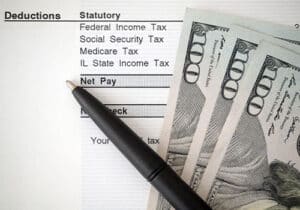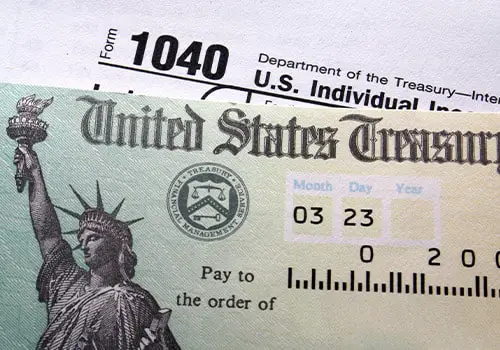If you have looked at your paycheck recently, you have likely noticed a lot of different taxes being withheld from your earnings. You probably already know what several of those taxes are.
Federal and state income taxes should be fairly obvious, but what about others, such as OASDI, FICA, or Social Security taxes?
Most people do not know what the OASDI tax is and why it is withheld from their paychecks each pay period. If you are wondering, “What is the OASDI tax?” then keep reading!
We will explain this tax, how it is calculated, and whether you can avoid paying it.
What Does OASDI stand for?
Most government programs have very long names, so they are typically given acronyms. The abbreviation OASDI stands for Old Age, Survivors, and Disability Insurance. Many people commonly refer to the OASDI tax as the Social Security tax.
What Is OASDI tax?
So, what is the OASDI tax deduction? The OASDI tax is part of the FICA taxes deducted from your paycheck.
“FICA stands for the Federal Insurance Contributions Act,” and this Act requires these taxes to be collected to fund both the Social Security and Medicare programs. FICA taxes include both OASDI taxes and Medicare taxes.
So, how do these taxes work? OASDI tax is due on all earned income. If you are employed, you probably haven’t even paid attention to this tax because it will automatically be deducted from your paycheck along with the other mandatory payroll taxes.
You are responsible for paying half the tax; your employer must pay the other half. Self-employed people will need to pay the total amount of the tax withholding themselves.
Here is how Social Security works. Once the OASDI tax is collected, it is placed into the Social Security trust funds. The Social Security Administration (SSA) uses the money from the OASDI tax to pay Social Security benefits to current beneficiaries.
Social Security is considered a pay-as-you-go system. This means the money collected from taxes is not placed into a personal retirement account.
Instead, the money collected today is used to pay benefits for today’s beneficiaries. When you retire, your retirement benefits will be paid by taxes collected from the current workforce.
KEY TAKEAWAYS
- The OASDI tax and the Social Security tax are terms used interchangeably, and they refer to taxes collected to fund Social Security programs (retirement, survivor, and disability insurance benefits).
- In a few instances, you might overpay your OASDI taxes. If this happens you can claim a refund on your federal tax return.
- You must pay the OASDI tax or Social Security tax unless you can claim one of a few rare exemptions.
OASDI Tax vs. Social Security Tax: Is There A Difference?
Many taxpayers wonder if there is a difference between OASDI taxes and Social Security taxes.
There is no difference between the two as long as you understand that Social Security taxes fund more than just retirement benefits.
- The OASDI tax and the Social Security tax are terms used interchangeably, and the two taxes are essentially the same.
However, some people might think that Social Security taxes only fund benefits for retirees, while the OASDI tax is more comprehensive since it directly includes old age, survivors, and disability insurance.
- OASDI taxes, or Social Security taxes, fund retirement benefits, survivor benefits, and disability insurance benefits.
These tax funds pay monthly benefits to the beneficiaries of these programs, and most people receiving these funds rely on them as part of their monthly budget.
Must read articles related to Taxes
- Figuring out payroll deductions and FICA tax.
- Learn if you can opt out of Social Security.
- Are there limits on Social Security Tax?
- How does the Social Security Trust Fund work?
- What does married filing separately mean, and should you do it?
How Does The OASDI Tax Work?

The tax rate for the OASDI tax is 12.4%. This is broken down into two components.
- The employee will pay 6.2% of their gross income into the Social Security trust funds.
- The employer will contribute another 6.2% of the employee’s earnings into the trust funds.
The total OASDI tax due is 12.4% of the employee’s gross earnings. The Internal Revenue Service (IRS) will review the employer’s and employee’s tax filings to ensure the proper amount of OASDI tax has been paid.
Failure to pay the right amount of OASDI tax could lead to fines, penalties, and hefty bills for back taxes.
Since self-employed individuals are technically both employees and employers, the OASDI tax works a little differently for them. In the next section, we will discuss how the OASDI works for self-employed individuals in more detail.
The 6.2% percent tax can add up, so is there a limit to how much tax you must pay? Thankfully, the answer is yes!
The 2024 Social Security tax limit is $168,600. This means you will only pay OASDI tax on your first $168,600 earnings. If you earn more than this amount, no OASDI tax will be due on the earnings above the limit.
However, this limit tends to increase each year. For example, the 2023 Social Security tax limit was only $160,200.
What happens if you overpaid your OASDI taxes?
It is possible to pay more than the limit accidentally. For instance, suppose you work two jobs but make less than $168,600 at each job. If the combined income from the two jobs exceeds the limit, you will likely pay more tax than is required.
This happens because your employers likely don’t know how much tax you have paid at another job. So, they will continue withholding the tax since they are each individually below the limit.
If you only work one job, your employer should stop withholding OASDI tax when you reach the limit.
If you pay more than the limit, you will be entitled to a refund of the overage. When you file your tax returns, you can get a refund of the amount you paid over the limit.
How are the OASDI taxes distributed?
Roughly 85% of the money collected from the OASDI tax is used to fund Social Security retirement benefits for retirees, spouses, and surviving spouses.
Approximately 15% of the money collected from the tax is used to fund Social Security disability benefits.
Less than 1% of the tax is used to fund overhead expenses for the Social Security program.
Remember that Social Security is the biggest line item in the federal government’s budget, so operating the program each year requires a lot of money.
OASDI Tax For The Self-Employed

We have already mentioned that the total OASDI tax rate is 12.4%, which is split equally between employees and employers.
So, what happens when you are both the employee and the employer?
This is the case for self-employed individuals. Unfortunately, if you are self-employed, you will be stuck paying the total amount of the tax. Many people call this the self-employment tax because you must pay double the amount of a regular employee.
Thankfully, the same OASDI limit applies to self-employed individuals, so there is a cap on the taxable wages subject to the 12.4% tax.
In 2024, your tax liability will max out once you hit $168.600 in taxable earnings.
Many self-employed individuals opt to create an S-corporation for their business instead of a single-member LLC or sole proprietorship to mitigate some of the taxes associated with being self-employed.
An S-corporation designation often leads to a lower overall tax bill, especially for those businesses with higher revenues and earnings.
Remember that most self-employed individuals also need to pay their taxes quarterly. If you wait until the end of the calendar year to calculate your taxes, you might find your bill extremely high. In addition, you could be hit with fines and penalties for not filing quarterly estimated federal tax returns.
You can always seek the advice of a personal finance expert or CPA for help with your taxes or check the IRS guidance for the rules on your situation.
TIP
In certain instances, a self-employed small business own may be able to reduce their tax liability my organizing their business as an S-Corp instead of a sole proprietorship, partnership or single member LLC.
OASDI Tax Limit 2024 Overview
Hardly anyone enjoys paying taxes, but a big bill can be disappointing. A tax rate of 6.2% is bad enough, but self-employed people will need to pay 12.4%.
Is there any limit to the amount of OASDI tax you must pay? The answer is yes, and here are the limits.
First, you should know that, unlike some payroll taxes, the OASDI withholding tax rate does not change based on your income. The rate rarely changes, even from one year to the next. However, there is a limit to the amount of tax you will owe.
OASDI Limit 2024
In 2024, the income limit for OASDI tax is $168,600. No tax will be due on any income above the OASDI limit. So, the most OASDI tax an employee will need to pay in 2024 is $10,453. Self-employed individuals can be liable for up to a maximum of $20,906.
OASDI Limit 2023
The OASDI tax limit in 2023 was $160,200, so the 2024 limit was increased by $8,400.
Is OASDI Tax Mandatory?
The short answer is yes, OASDI taxes are mandatory. Roughly 96% of working Americans pay the OASDI tax.
There are a few limited exemptions to this tax, and falling under one of these exemptions can be quite difficult.
- Foreign researchers or other academic employees who are not U.S. citizens or permanent residents can be exempt from the tax.
- Some religious organizations are exempt from the tax.
- Some public sector workers, like members of Congress, who are covered under another retirement plan, are exempt from the tax.
- Enrolled students who work for their university can be exempt from the tax.
In some situations, to claim the exemption, you must generally waive your rights to all future Social Security benefits.
This means that you will need to have a separate retirement plan and agree not to apply for Social Security benefits.
Even if you fall under an exemption, you must still take action to stop the tax collection. An exemption is not automatic for those who fall into one of the exempt categories.
You must file Form 4029 with the IRS to notify them that you are exempt from OASDI taxes.
The Bottom Line
OASDI taxes collect money to fund the Social Security program, which includes retiree, survivor, spousal, and disability insurance program benefits.
The OASDI tax and the Social Security tax are essentially the same thing. The OASDI tax rate is 12.4%, but an employer contributes half the amount (6.2%) on behalf of the employee.
Participation in the OASDI tax is mandatory, and nearly all U.S. workers pay this tax. While a few limited exemptions exist, qualifying for an exemption can be challenging.
Frequently Asked Questions
No, the OASDI tax is different from the federal income tax. Now, you might be wondering, “What is OASDI on my paycheck?”
While the OASDI tax is a federal tax, it is not a tax that goes to the general budget of the federal government. OASDI taxes are specific taxes collected to fund the Social Security program. Federal income tax rates change on a sliding scale depending on your income.
However, the tax rate for OASDI remains static at 6.2%. Unlike federal income tax, there is a limit to the amount of OASDI tax that you will owe each year.
The total tax rate for OASDI is 12.4%, but this amount is split equally between the employee and the employer.
This means you will see a tax rate of 6.2% deducted from your paycheck during each pay period. If you are self-employed, you must pay 12.4% since you act as both the employee and employer.
The OASDI tax limit 2024 is $168,600, so you will not owe any OASDI tax on earnings above this limit.
There are a few limited circumstances under which you can opt out of the OASDI tax, but these cases are rare.
Opting out of the OASDI tax means giving up your rights to any future Social Security taxes. This sometimes happens with foreign students who work in the academic world in the United States.
In addition, some religious organizations can get an exemption from OASDI taxes. These organizations do not believe in social programs like Social Security and solely fund their own retirement plans. In some limited cases, these groups can get religious exemptions from the OASDI tax.
OASDI tax is withheld from your paycheck because it is a mandatory payroll tax collected by the federal government.
OASDI taxes fund the Social Security program, which is vital to supporting the program’s financial obligations.
Once you have reached $168,600 in earnings in 2024, you should no longer see OASDI tax withheld from your check. However, you should know that the tax limit typically increases each year.
Yes, you must pay OASDI tax even if you are self-employed. You will owe twice as much tax as a regular employee.
Since the OASDI tax is split equally between the employee and employer, self-employed individuals must pay the employee and employer portion of the tax.
This means their tax liability will be 12.4% instead of just the 6.2% employees must pay.
You can find a Social Security Administration office near you by using our SSA office locator and searching for your closest location.





